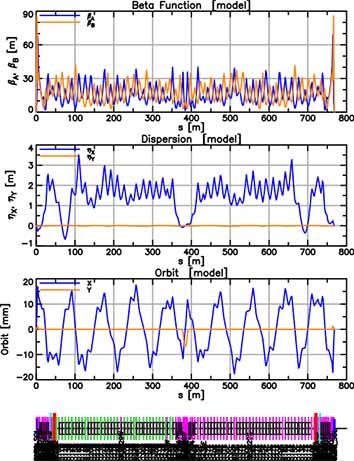You are here: CLASSE Wiki>ACC/ACL Web>WebLeftBar>RunningPrograms (19 Apr 2024, DavidSagan)Edit Attach
Running Programs
it is assumed that if you are running Off-Site then a Bmad Distribution has already been built or you are using a Conda-Forge instance. If not, please consult the instructions for Distribution or Conda-Forge Setup.Environment Setup
The first thing to do is to check that your environment has been properly setup. To do this, use the commandaccinfoThis command should display a summary of the active Distribution's information, build architecture, selected Fortran compiler and enviromental configuration. If not, instructions for setting up the environment for a Distribution is given here. On-Site environment setup is given here.
List Programs
To get a list of the Bmad programs that have been built use the command:ls $ACC_EXE[If On-Site you will also see other CESR related programs.] Note: If you have built your own custom program, this program will not be in the $ACC_EXE directory (unless you have done your program build from within the Distribution tree which is not recommended). See the build system documentation for infomation on building your own Bmad based programs.
Run a Program
The $ACC_EXE directory is in the system path so you can type the name of any of the programs that are in the directory to run the program. As a test you can run the Tao program:tao -lat $ACC_ROOT_DIR/tao/examples/cesr/bmad_L9A18A000-_MOVEREC.latAssuming there is no tao.init file in your working directory, running Tao should result in a plot window poping up that looks like:

Running Parallel Programs with MPI or OpenMP
Some Bmad based proprograms can use OpenMP or Open MPI to run multi-threaded. The documentation on an individual program will indicate if this is possible for that program. When building an Off-Site Distribution, to compile with OpenMP, set the ACC_ENABLE_OPENMP variable in the util/dist_prefs file to "*Y*". To compile with MPI, set the ACC_ENABLE_MPI varible in the util/dist_prefs file to "*Y*". There is a plethora of information on the web about OpenMP and MPI. Briefly, with OpenMP, computation is done on a number of cores on the machine you are connected to. With OpenMP, simply set the number of threads by setting the environment variable OMP_NUM_THREADS before running the program. Example:export OMP_NUM_THREADS=8An MPI program can run with multiple cores on a single machine or be distributed accross a cluster. How to run on a cluster is cluster dependent so see your local cluster Guru for details (for Cornell's Compute Farm documentation is here). For running an MPI program on a single machine, use the mpiexec or mpirun (which ever works for you) command. For example the command might look something like:
mpiexex -np 12 ../production/bin/lux_mpiwhere the -np switch sets the number of threads.
Edit | Attach | Print version | History: r8 < r7 < r6 < r5 | Backlinks | View wiki text | Edit wiki text | More topic actions
Topic revision: r8 - 19 Apr 2024, DavidSagan
Build System Quick Links
-
 Main Page
Main Page
-
 Definitions
Definitions
-
 Running Programs
Running Programs
-
 Bmad Installation
Bmad Installation
("Off-Site") -
 CLASSE Release
CLASSE Release
Setup -
 Bmad Build System
Bmad Build System
-
 Cornell Build System
Cornell Build System
-
 Download Bmad
Download Bmad
-
 View Code
View Code
-
 ACC SVN Repository
ACC SVN Repository
-
 Troubleshooting
Troubleshooting
-
 Bmad Doc
Bmad Doc
-
 Help / Mailing Lists
Help / Mailing Lists
- ACC/ACL Web
- Repository Info
- Browse
- WebDAV access
- ACC Development Mailing List
- Send
- Subscribe
- Unsubscribe
- See which mailing lists you're on
- Help Queries and Report requests
- Email a problem or bug report
- View RT Tickets
- Getting Help
- CLASSE Computing Info
- CLASSE
Create personal sidebar
 Copyright © by the contributing authors. All material on this collaboration platform is the property of the contributing authors.
Copyright © by the contributing authors. All material on this collaboration platform is the property of the contributing authors. Ideas, requests, problems regarding CLASSE Wiki? Send feedback
